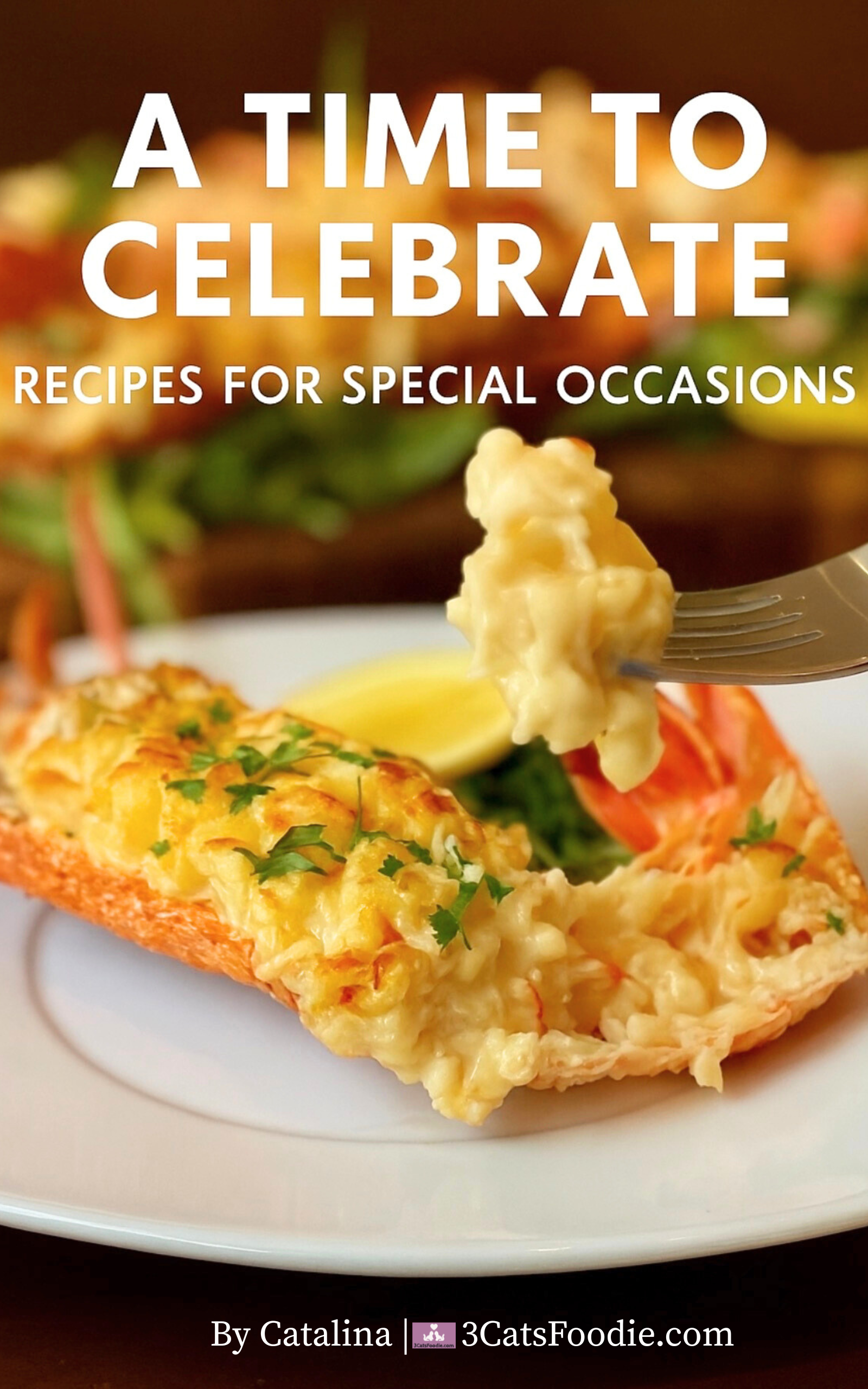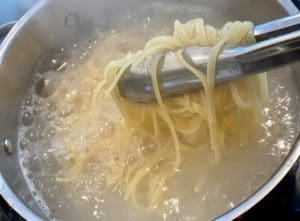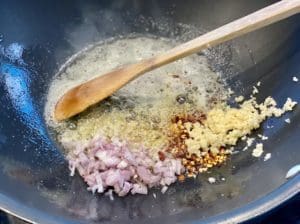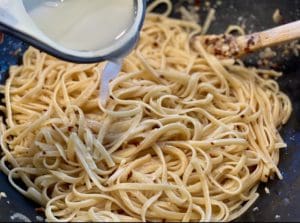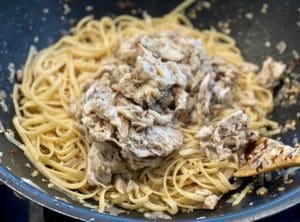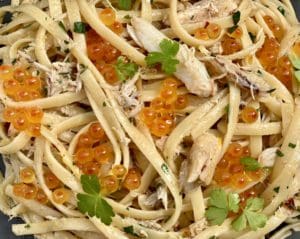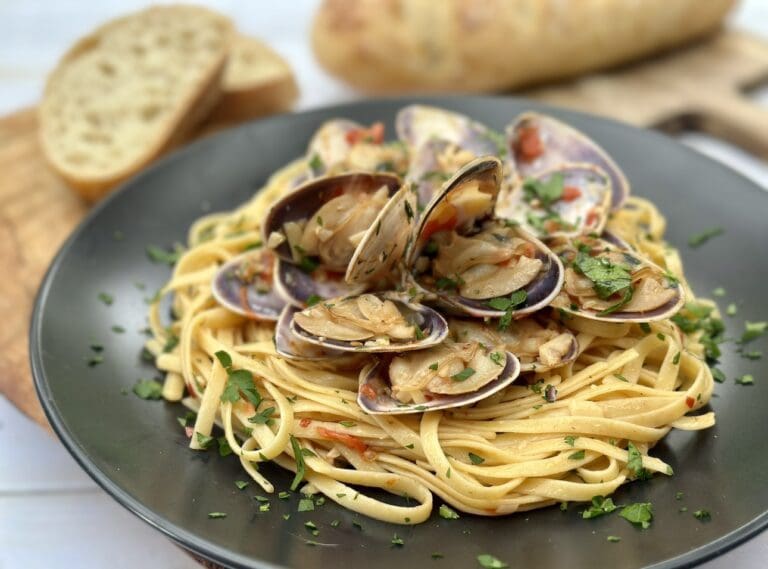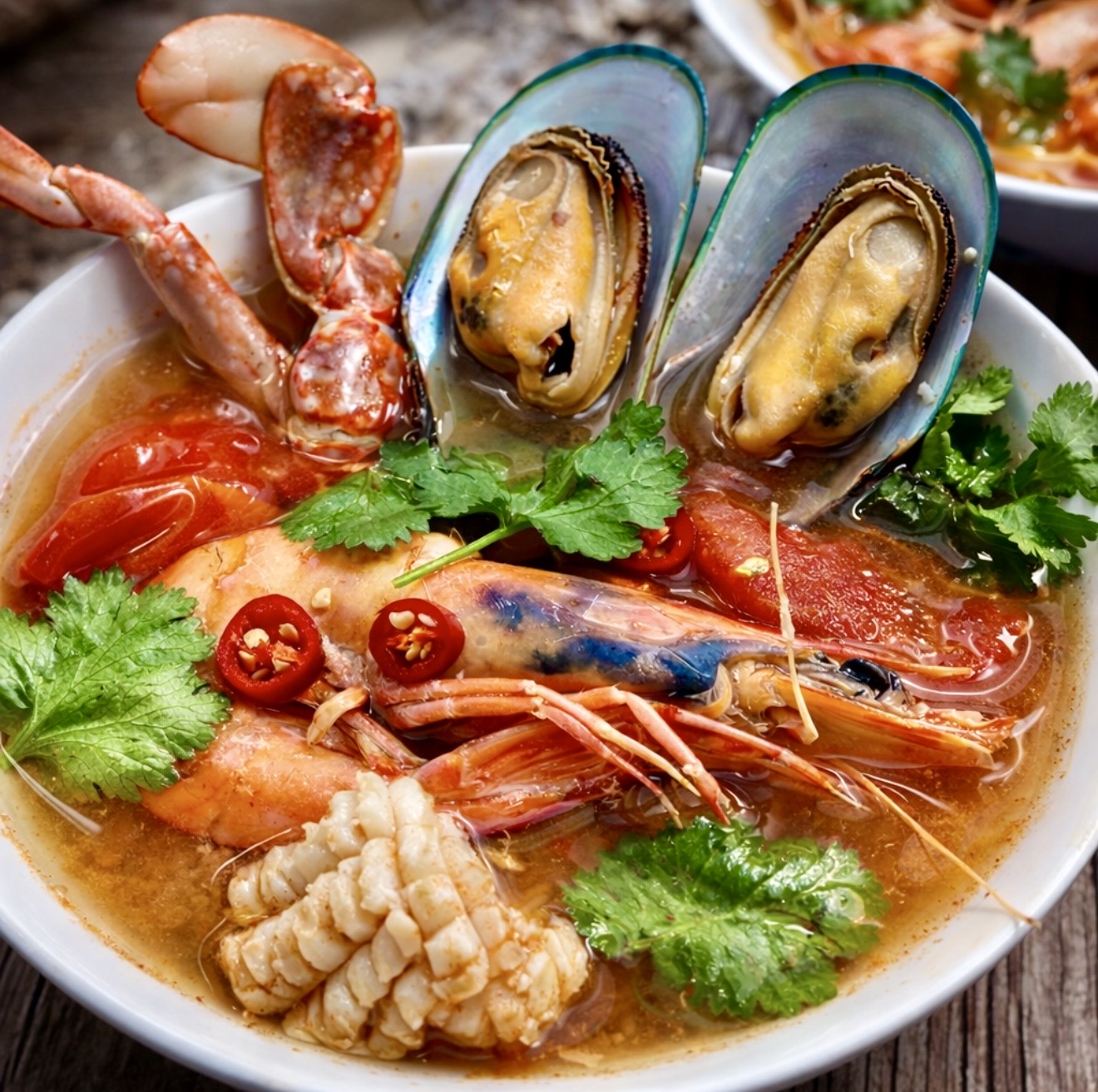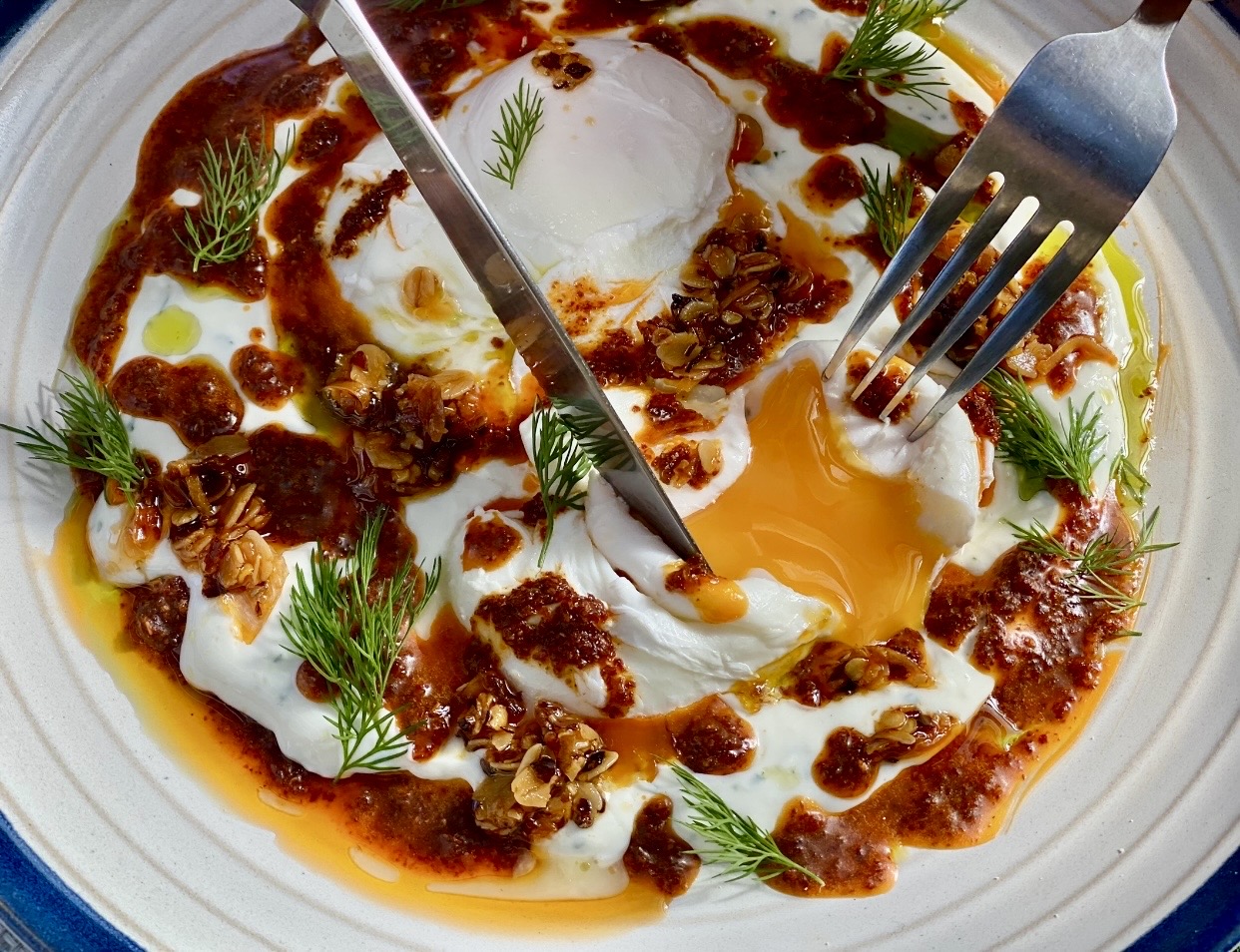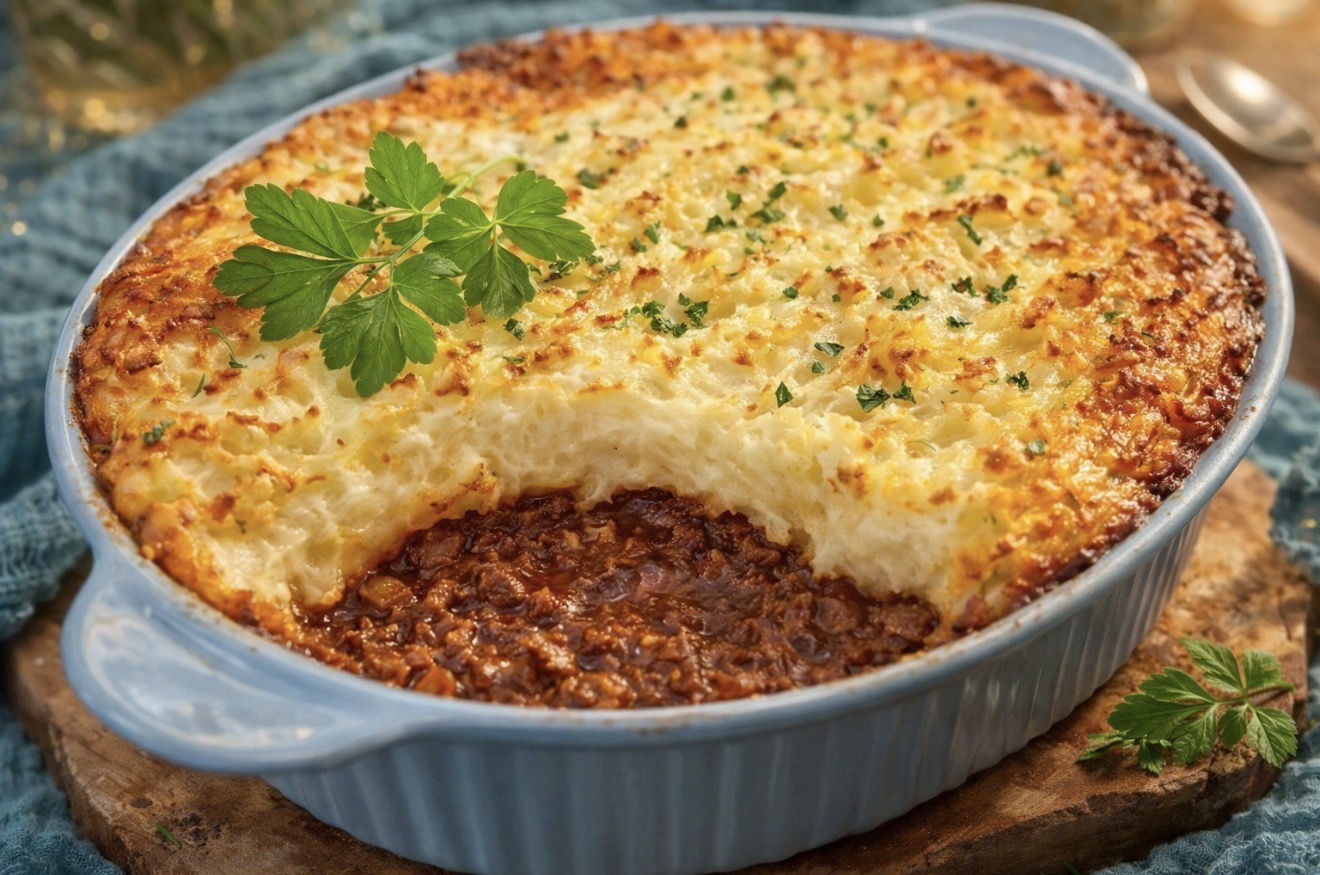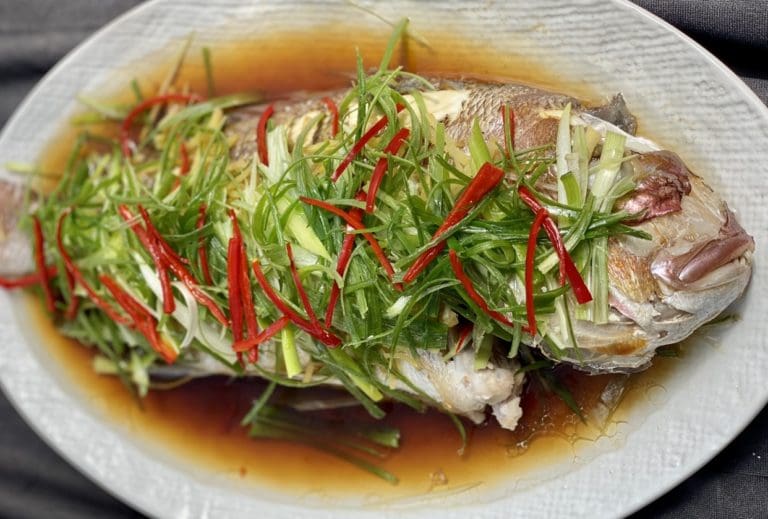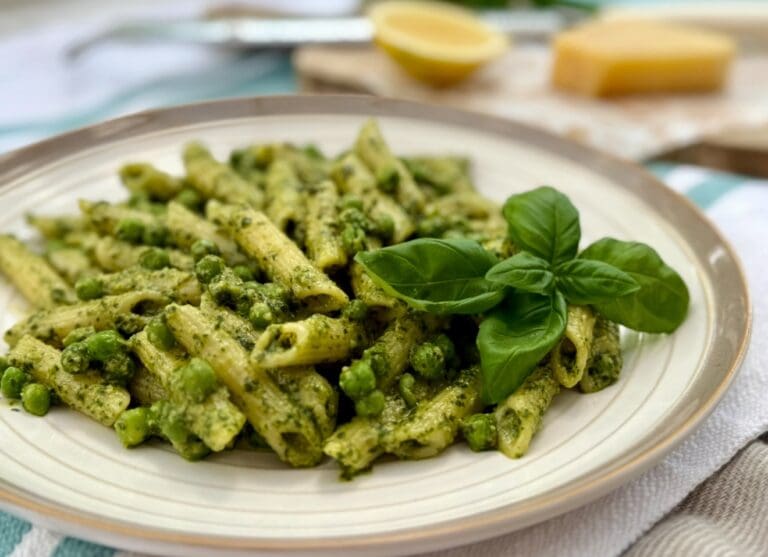Crab Linguine with Caviar
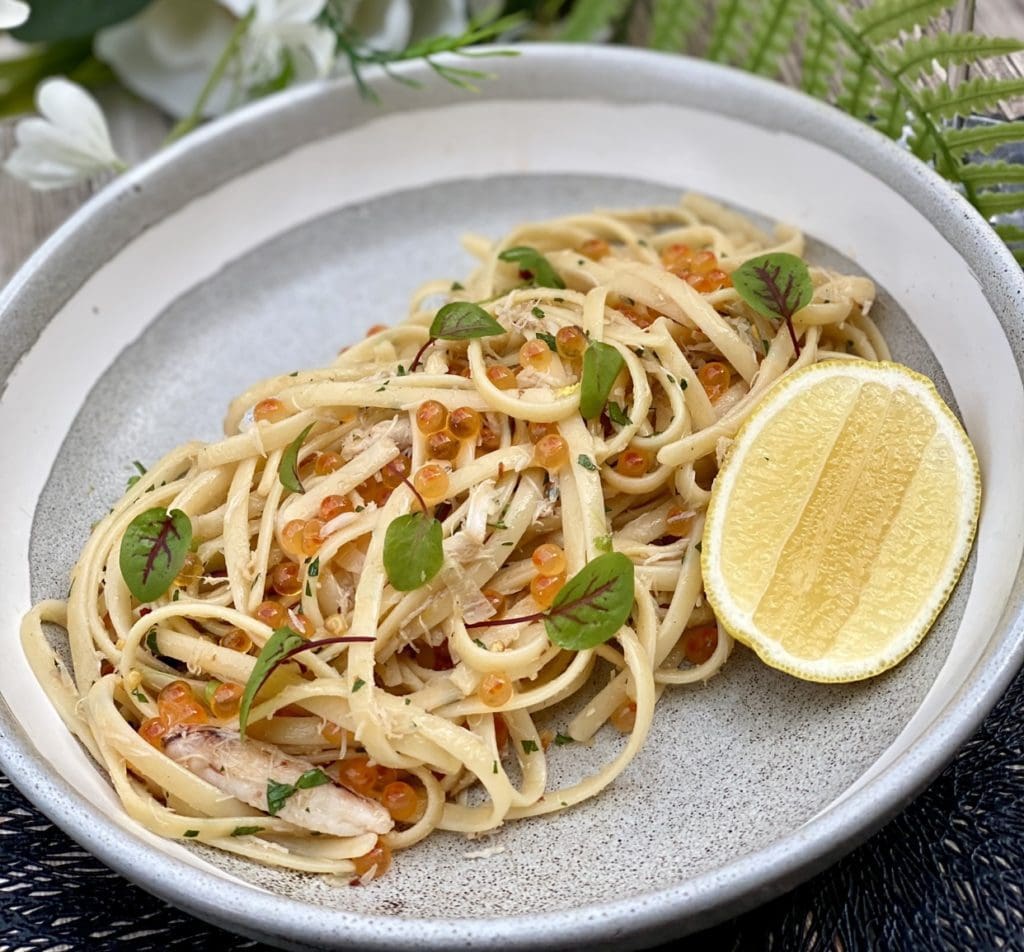
This gorgeous and mouthwatering Crab Linguine pasta has chunks of crabmeat with luscious little pops from the salmon caviar
Crab and caviar, what more would you want?
Dare I say this? But I don’t want to say it out loud. I think I may prefer crab to lobster.
I came to this realisation when we dined at Epicurean, at The Crown Buffet buffet for my birthday last month. As usual, I made a beeline for the chilled seafood section. They had an impressive range. I’ve never seen Alaskan crab legs and lobster tails in an all you can eat buffet before!
My first plate of oysters had Alaskan crab legs and oysters, but strangely enough, no lobster. I only thought of having some lobster as an afterthought when I was almost full from stuffing my face in other dishes. I didn’t want to leave the expensive buffet without having lobster!
In their simple fresh, cooked and chilled form, I prefer crabs to lobsters because their flesh is tender and tastier. However, when I think about Lobster Mornay or Singaporean Crab, things get a little complicated.
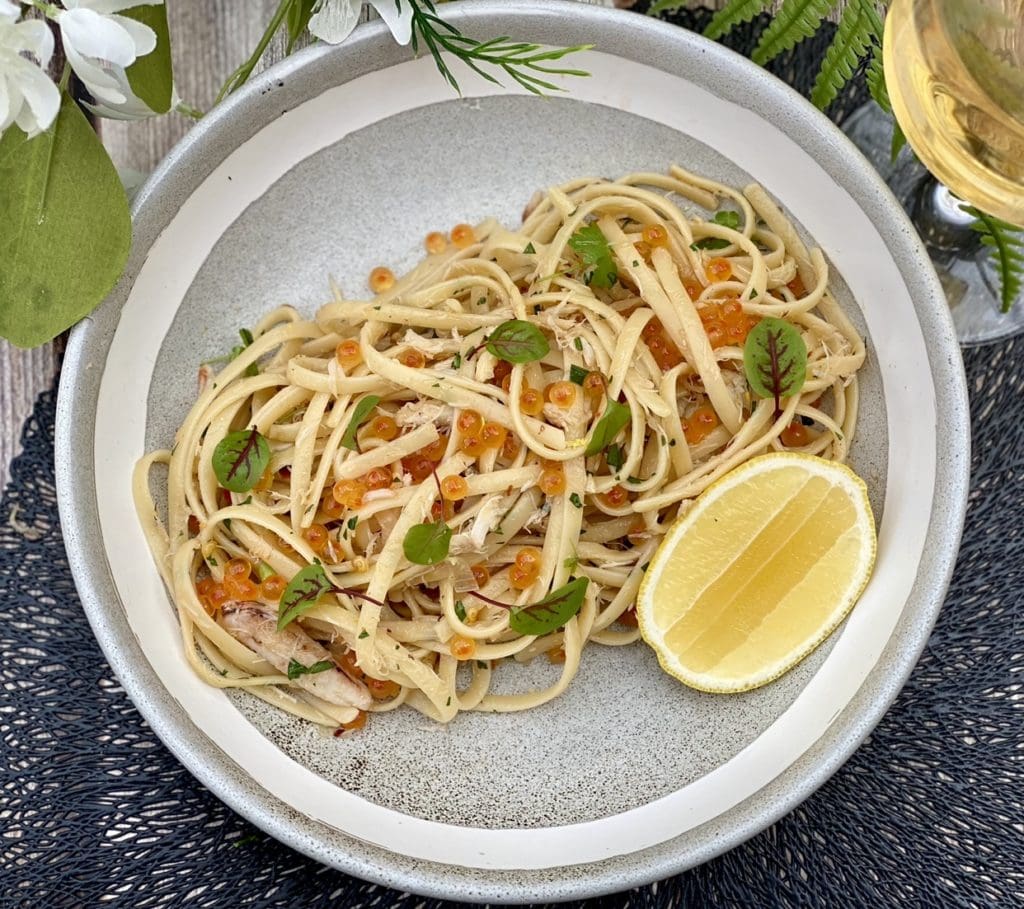
Today, we’re going to throw our support behind the creature that walks sideways. Oh gosh, I shouldn’t have mentioned that because now I feel guilty eating them because that’s just endearing.
This elegant linguine is just delightful, with chunks of crabmeat and gorgeous shiny salmon caviar pearls. A simple but delicious pasta cooked in olive oil with butter, garlic, chilli flakes, white wine and lemon.
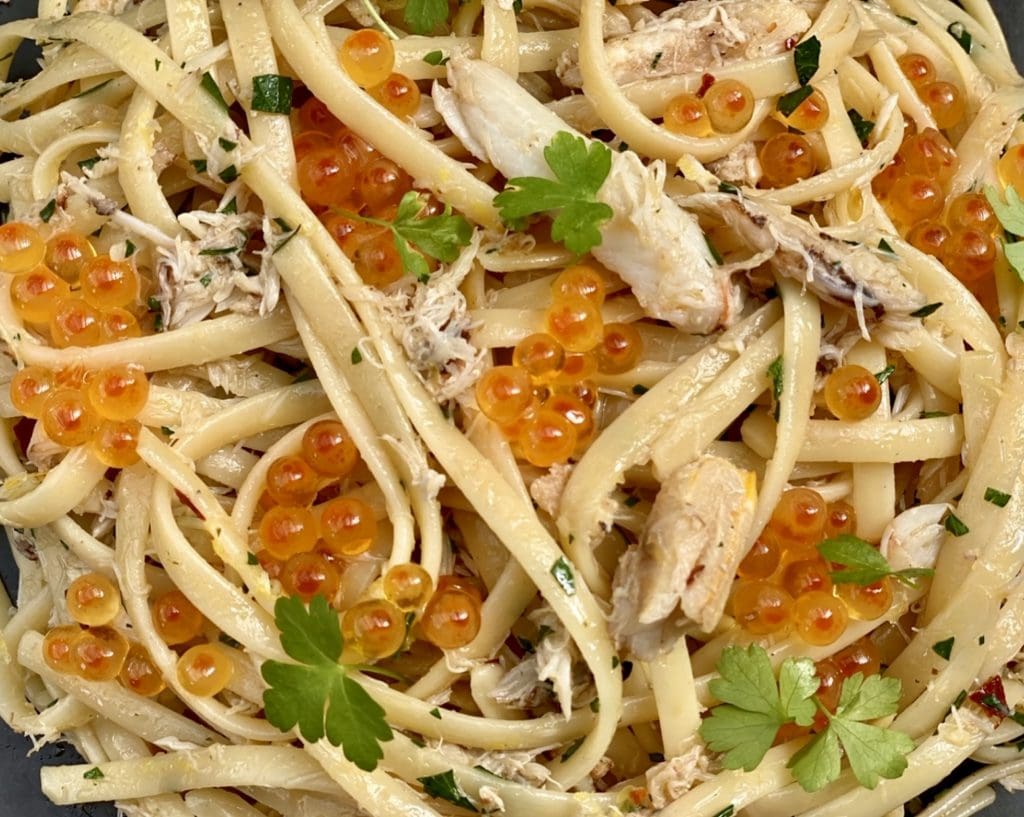
Awkward Team lunches
I got the inspiration for this recipe from a team lunch we went to in my last job. We ordered Crab linguine and salmon caviar in an Italian restaurant near our workplace.
Don’t you just love it when our work invites us to a team-building lunch but we have to pay for it? It’s one of those situations where work tells us it’s optional to go, but if we choose not to attend, people will think we’re antisocial.
My husband, Tomasi, likes to poke fun at the companies I’ve worked in. Coincidently, all my previous companies made us pay for our lunches, whereas his companies have always paid for his.
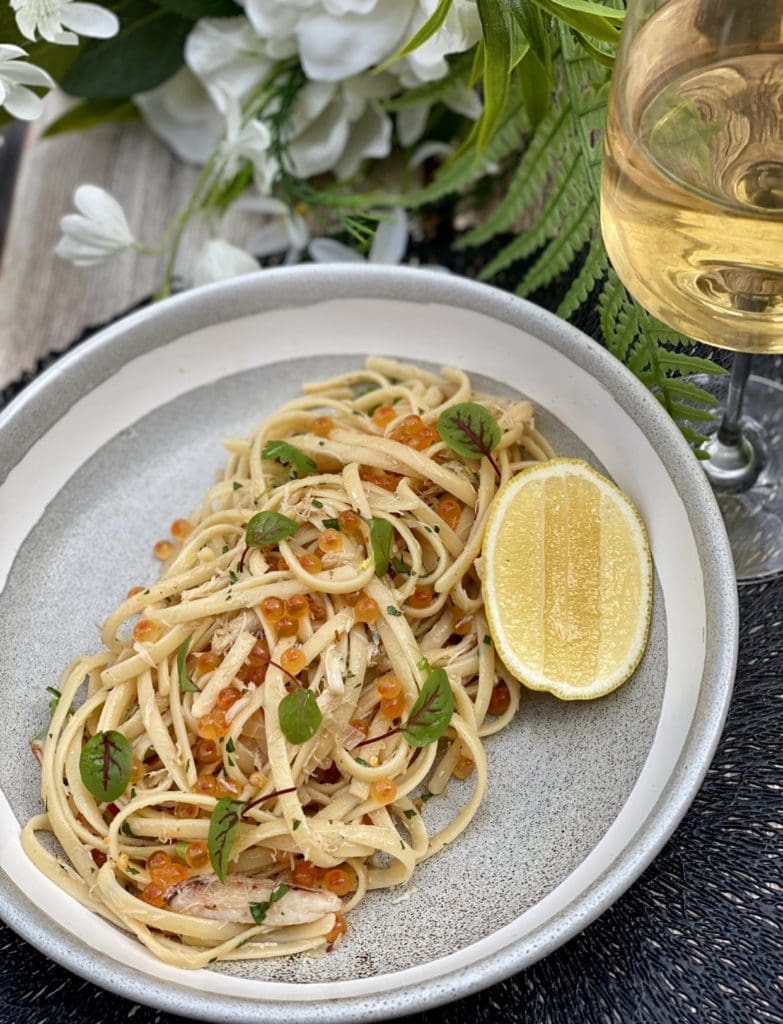
I don’t mind going and paying as long as it’s at a decent place with people I enjoy interacting with. In my last job, I got along really well with a lady that sat across from me. She was in the Compliance team, but we worked closely together as we were in the law sector.
Her name is Hilary, one of my most feisty and fiercely loyal friends I have. Hilary was the best thing about working in my last job. We would grab our coffees every morning together and go clothes shopping during our lunch breaks. I should get in contact with her again as it’s been too long!
This pasta dish reminds me of Hilary because we ordered Crab pasta together on one of our work lunches. She prefers red meat and I prefer seafood, but we still agreed to share a pizza and pasta. She choose the pizza and I choose the pasta. When she found out what I ordered, she teased me and said ‘What?! you ordered ‘crap’ linguine?‘. She ate her words when the pasta came because she ended up loving it as much as I did.
More mouthwatering seafood pasta recipes to try:
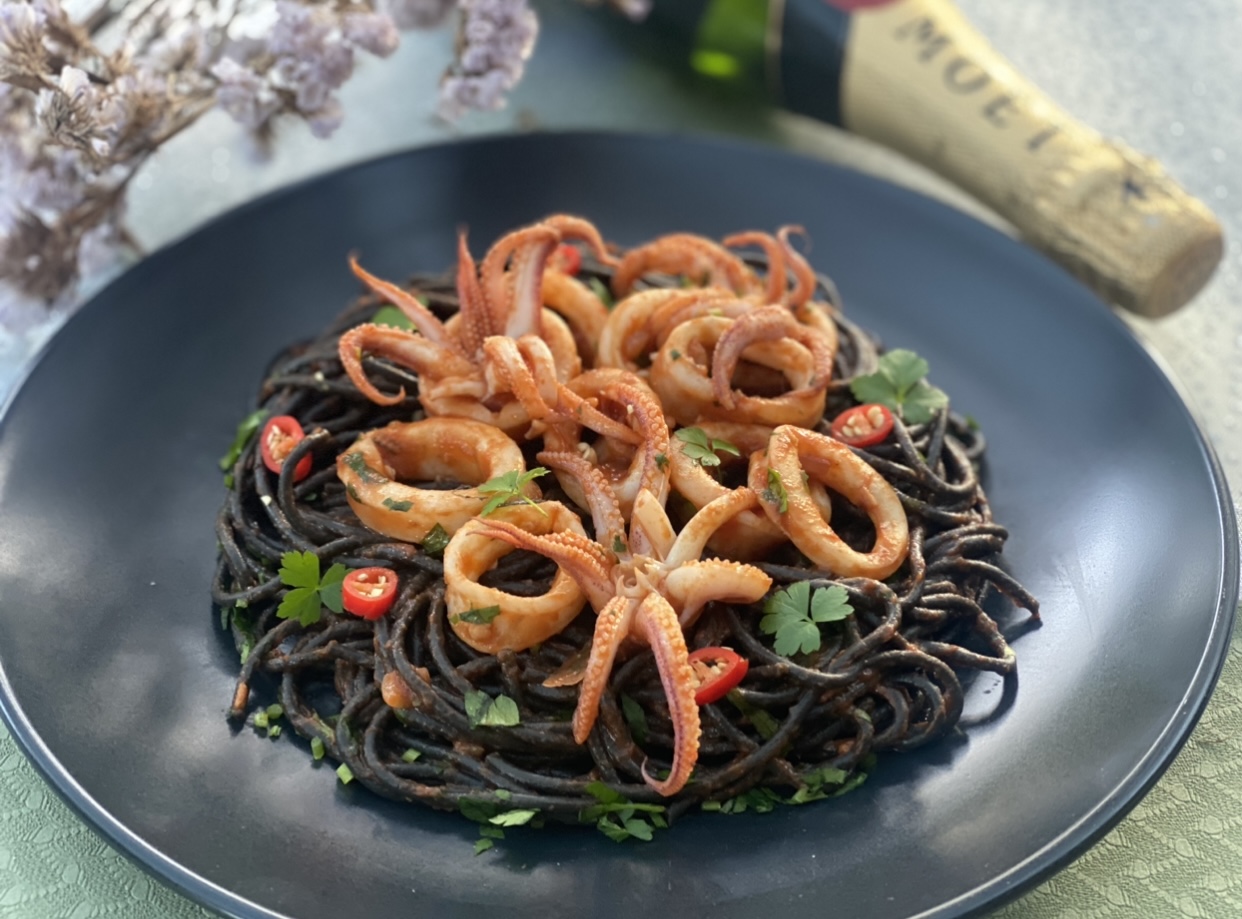
Spicy Squid Ink Pasta with Calamari
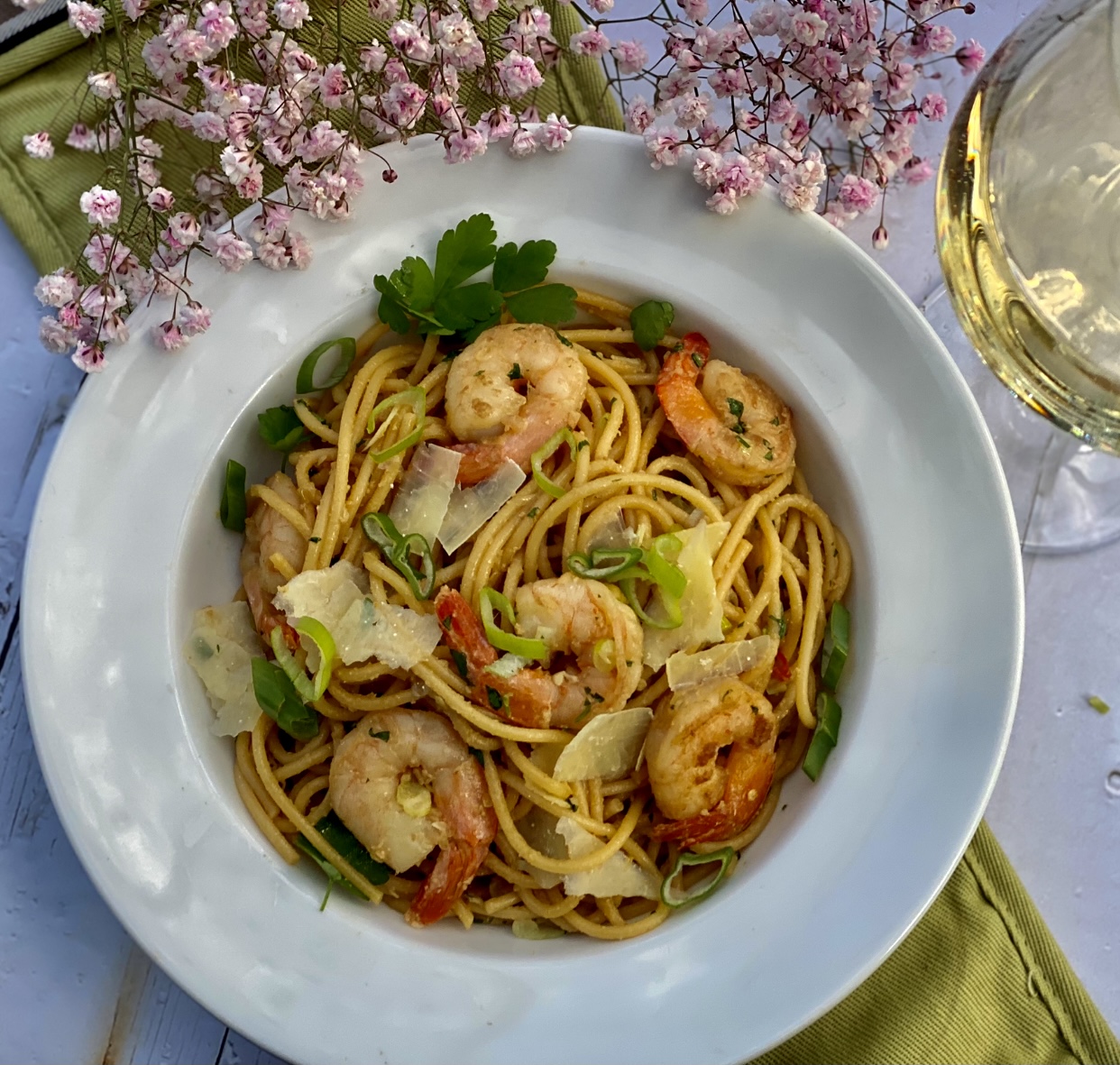
Prawns Butter Soy Pasta
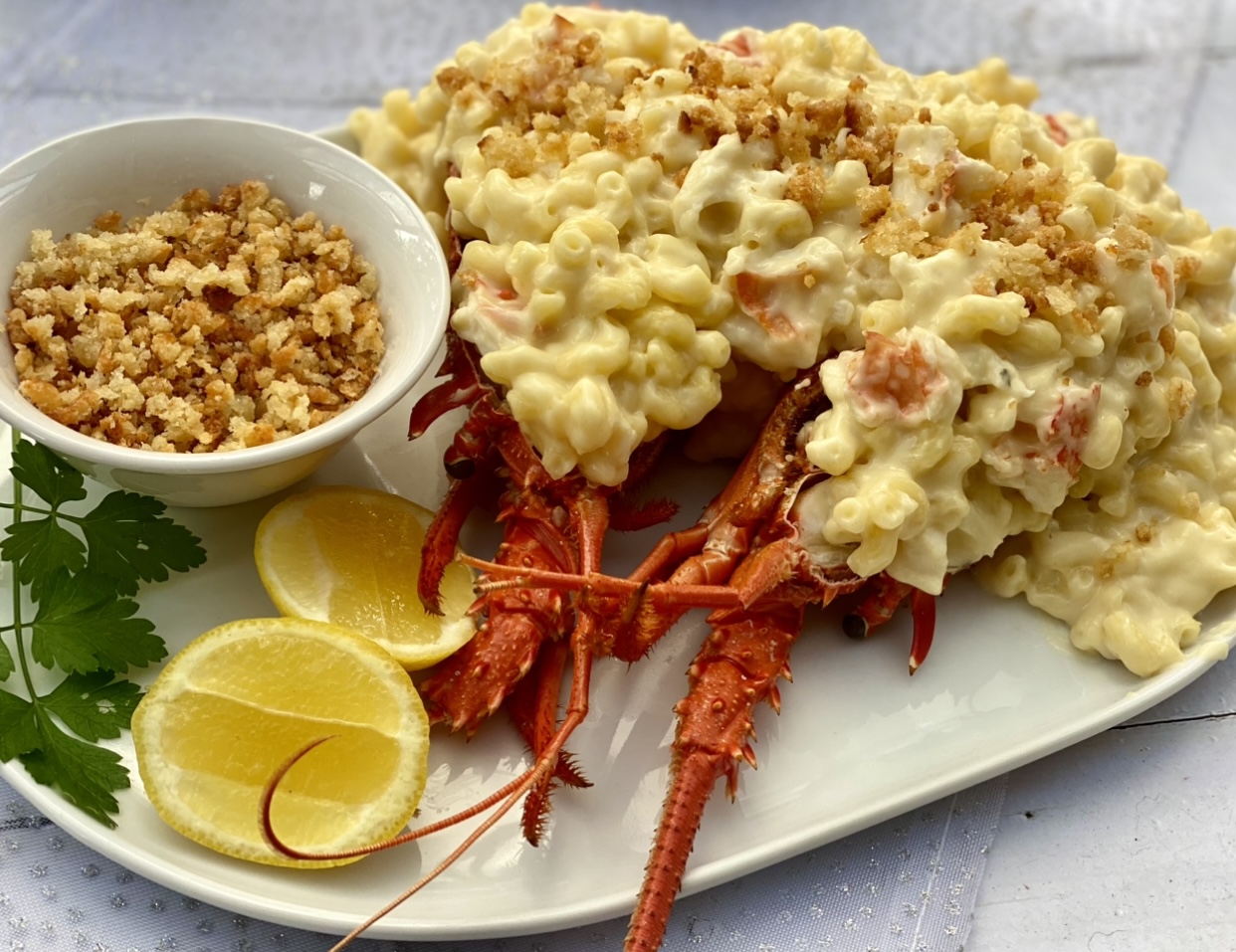
Creamy Lobster Mac & Cheese

One-pan Garlic Chilli Prawn Pasta
Ingredients for Crab Linguine with Caviar
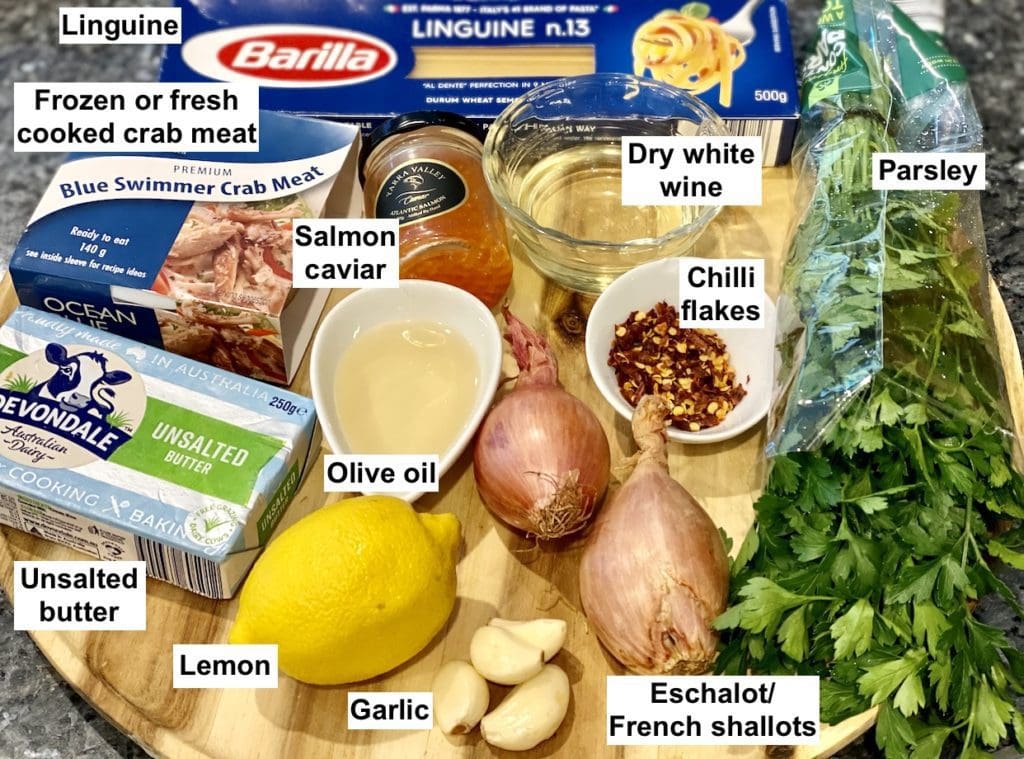
Crabmeat – On this occasion, I used the cooked crabmeat that was sold in the chilled section. Unfortunately, it had very strong seafood and ‘tin’ taste. I would recommend using freshly cooked crabmeat (I know it’s labour intensive to remove) or frozen cooked crab meat. These options make this pasta dish taste so much better. If using frozen crab, defrost it first and remove any excess liquid from the crab.
Linguine tends to be paired with crab and pasta, so I used linguine. However, if you don’t have linguine in the pantry, you could use spaghetti for fettuccine or any type of long pasta.
Eschalots (French shallots)- It’s so confusing, right? Shallots, green onions, spring onions and other small onions. It also doesn’t help that other countries call the same onions a different name! I’ve seen the stores here call shallots ‘eschalots’ or ‘French shallots’. Eschalots look like small brown onions but are skinny and oval-shaped. They’re difficult to peel and are way more expensive than other types of onions. They’re mild in flavour compared to onions, brown and red onions will work, but use half of the amount called for in the recipe.
Dry white wine is lower in sugar levels than other varieties of white wine. Sauvignon Blanc, Chardonnay and Pinot Grigio are popular dry white wine varieties.
Salmon caviar (salmon roe) – I picked up a jar from my local fishmonger. They’re quite expensive and once you’ve opened the jar, you have 4 days to consume it. If you’re not planning to use caviar for another dish, go for the smallest jar.
Subscribe to 3CatsFoodie’s FREE Newsletter

For the latest recipes and other fun stuff!
Crab Linguine with Caviar
Step-by-step guide with photos
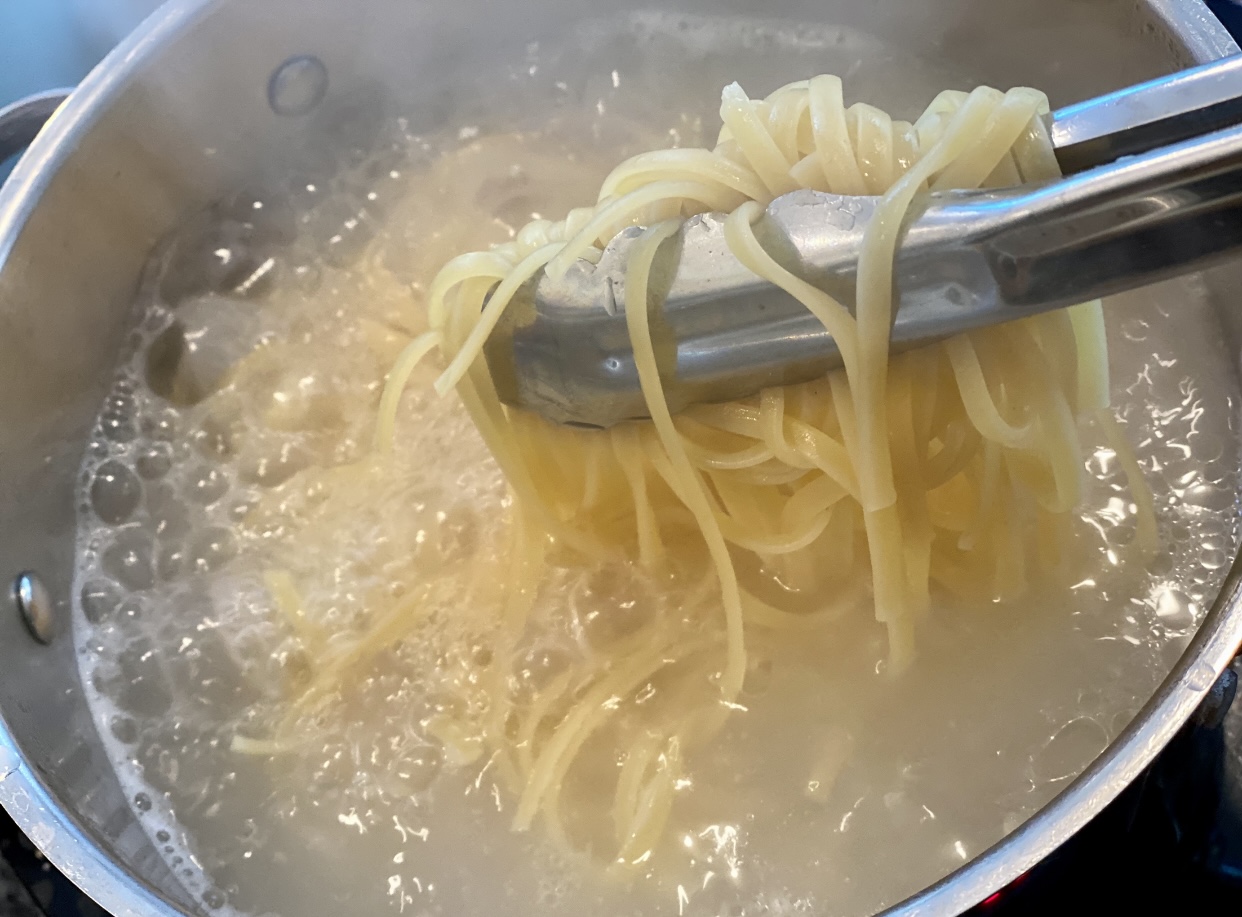
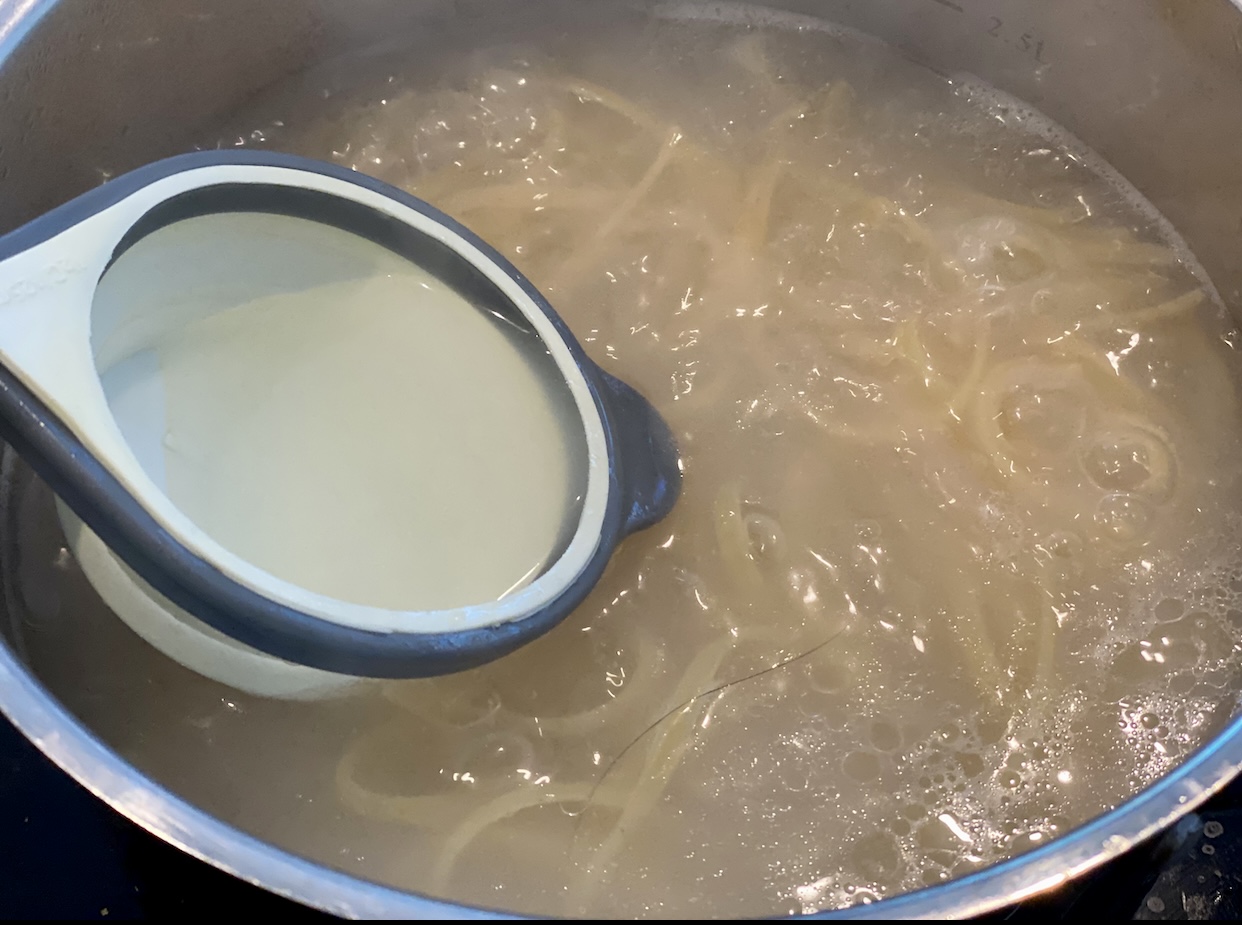
Cook the pasta as per the instructions on the packet but make sure not to overcook it. The pasta should be a little firm when bitten (al dente). Scoop half a cup of pasta water and set aside, then drain the pasta using a colander. Rinse the pasta with cold water and set it aside in the colander for later.
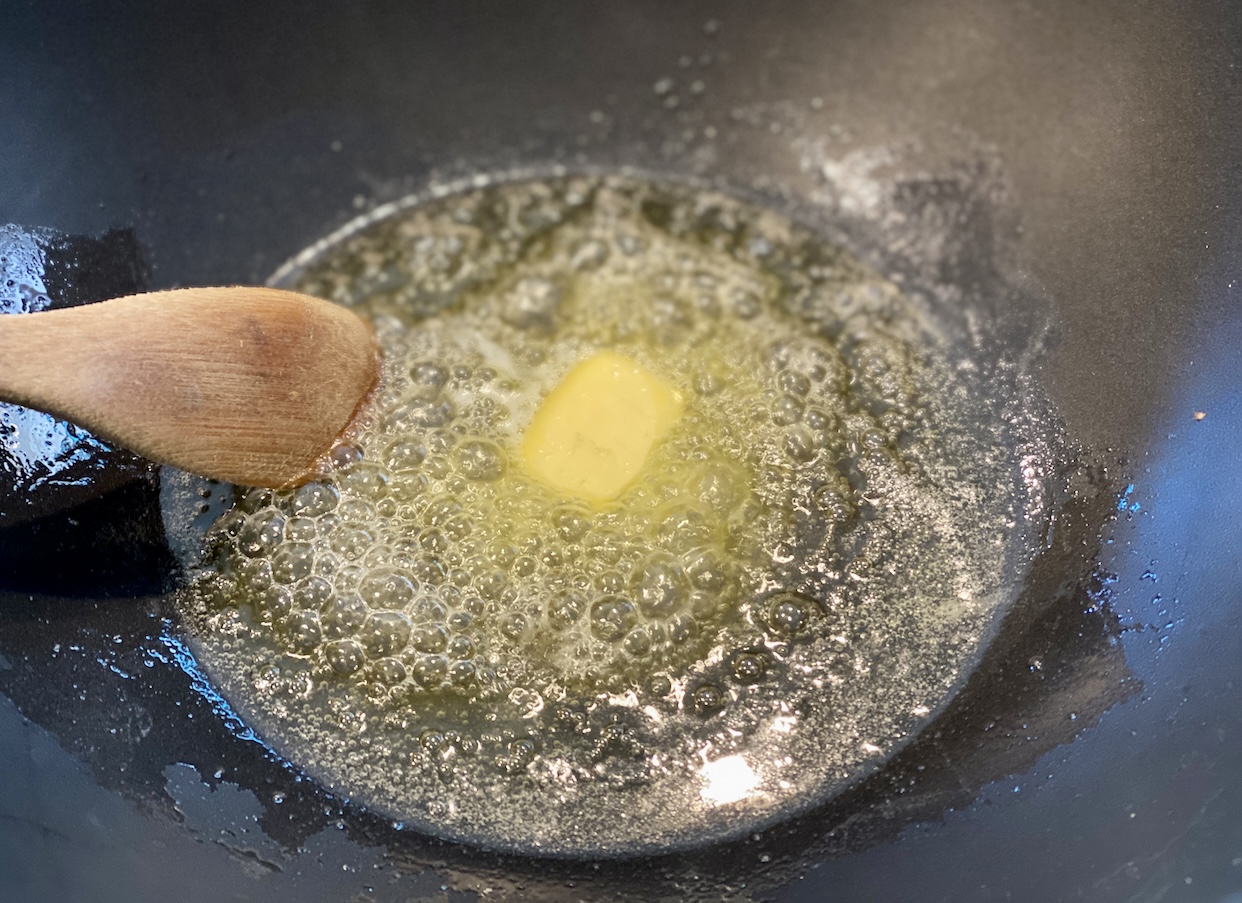
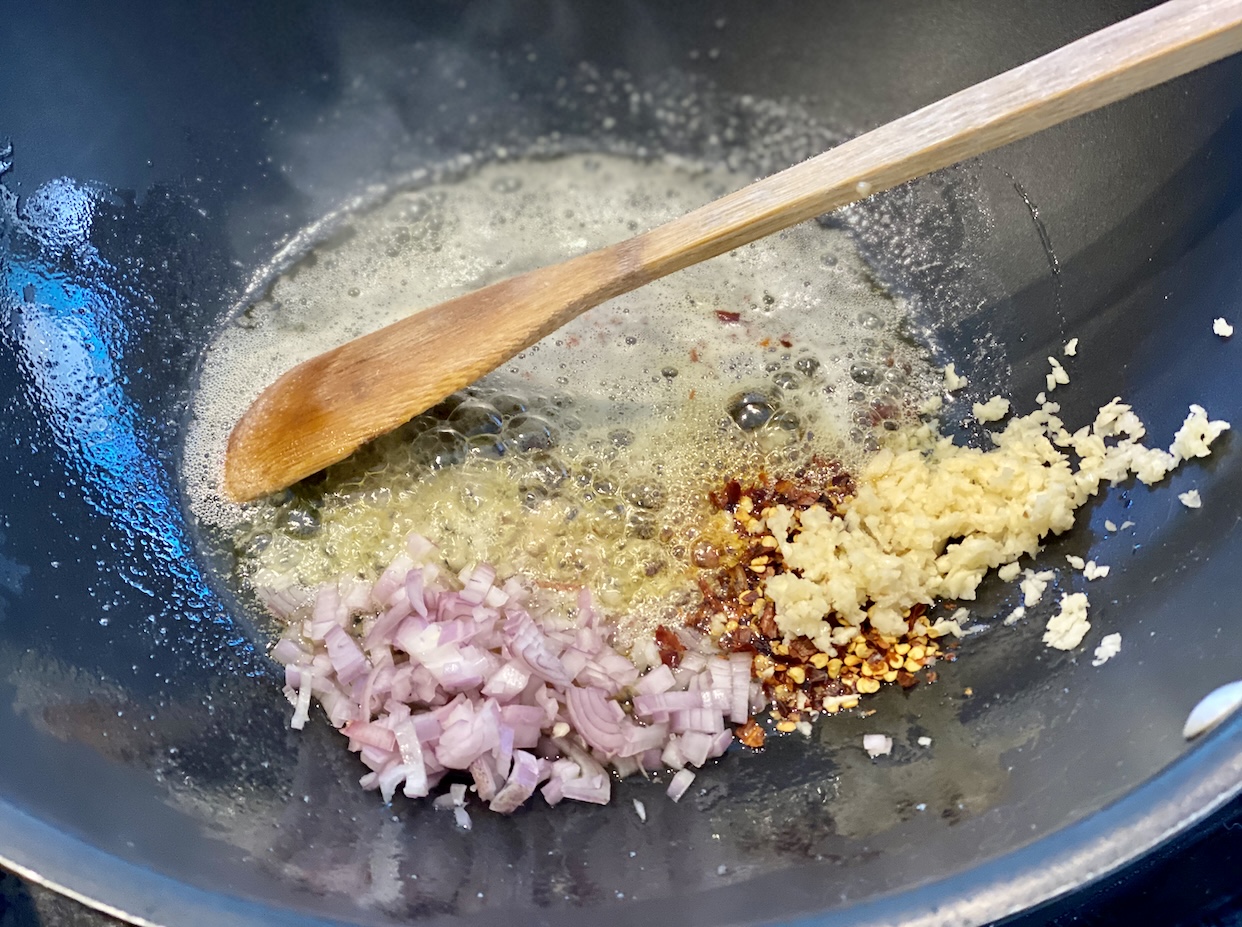
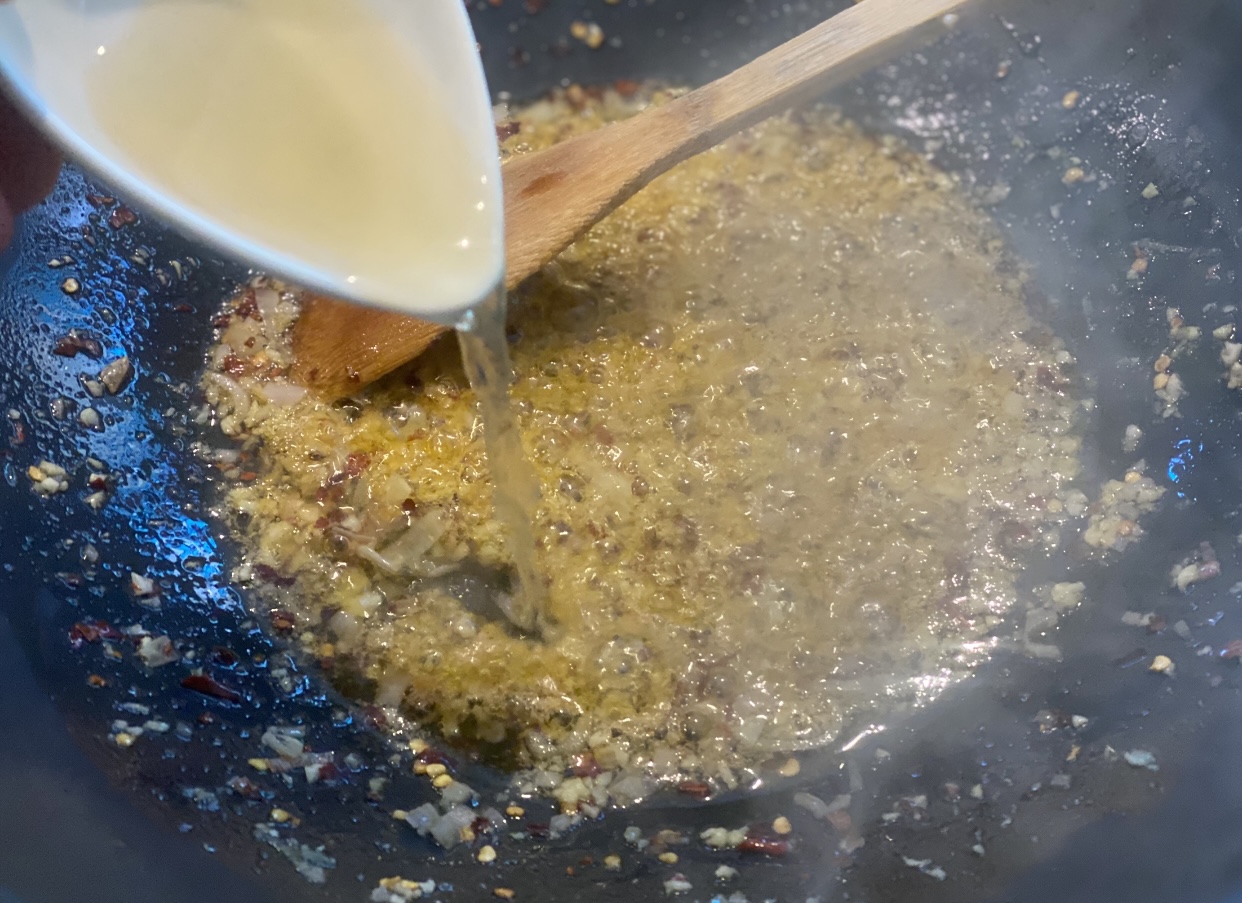
Heat the oil in a large and deep-frying pan over medium-high, then add the butter. Once the butter has melted, add in the garlic, eschalot, and chilli flakes. Stir quickly for 30 seconds or until aromatic, but don’t let it burn. Pour in the wine and cook until the alcohol smell disappears.
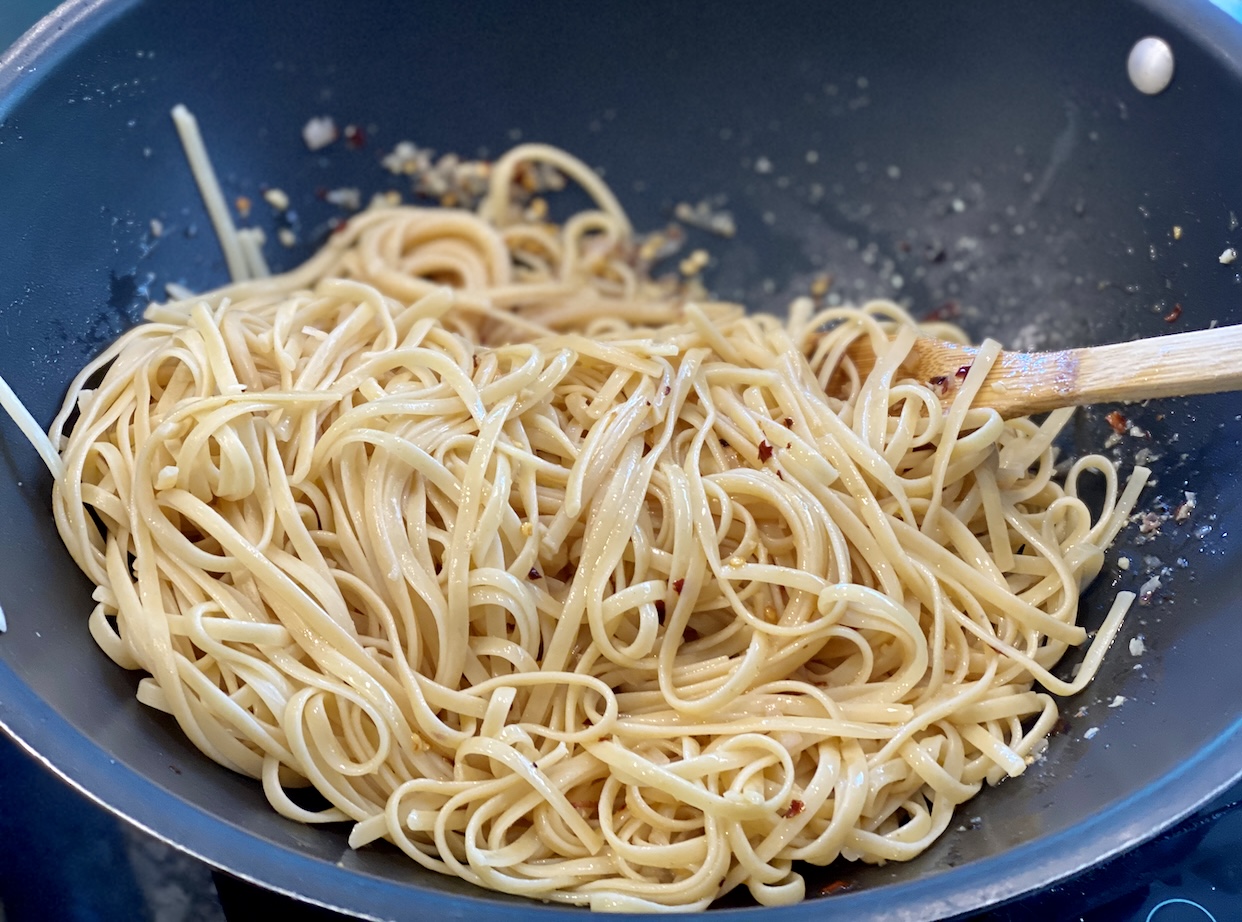
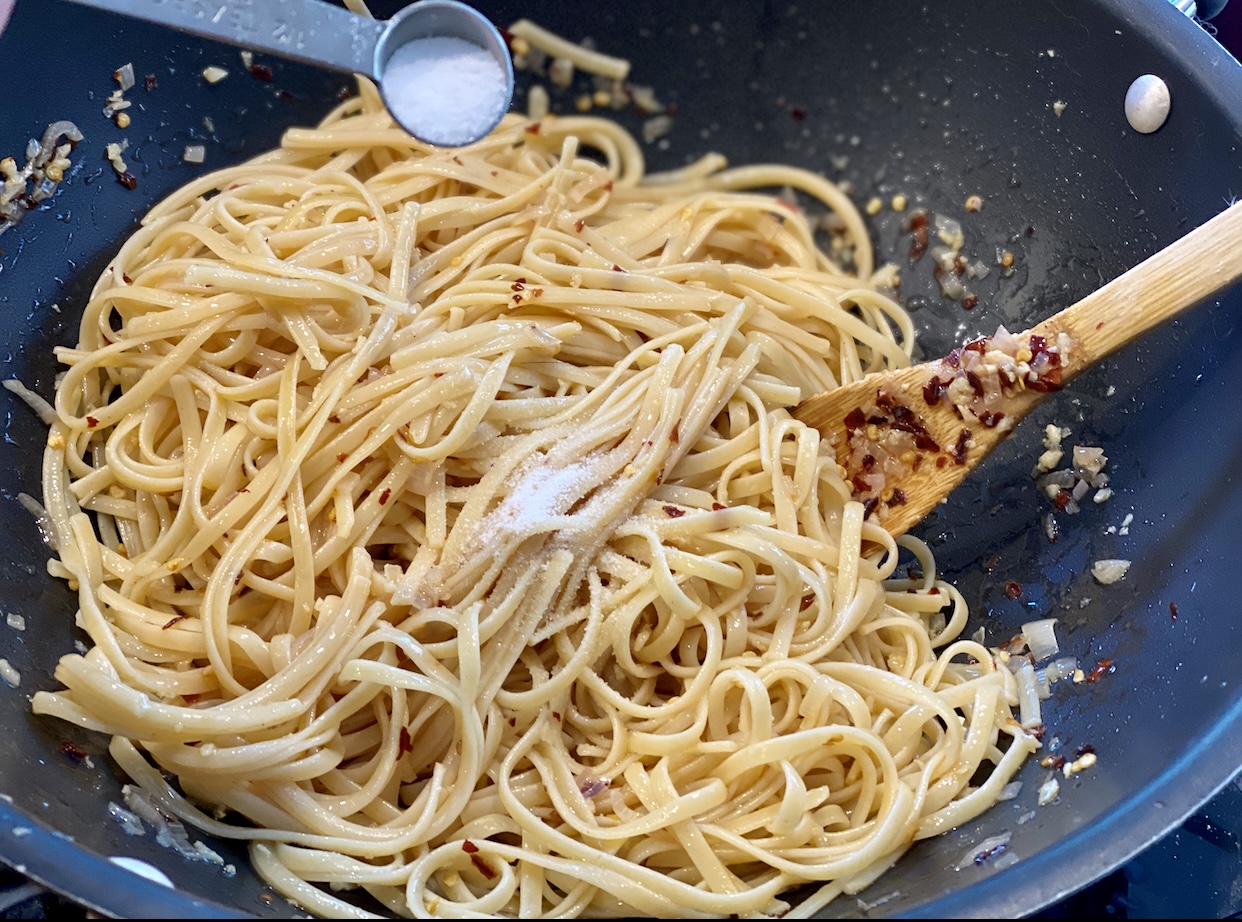
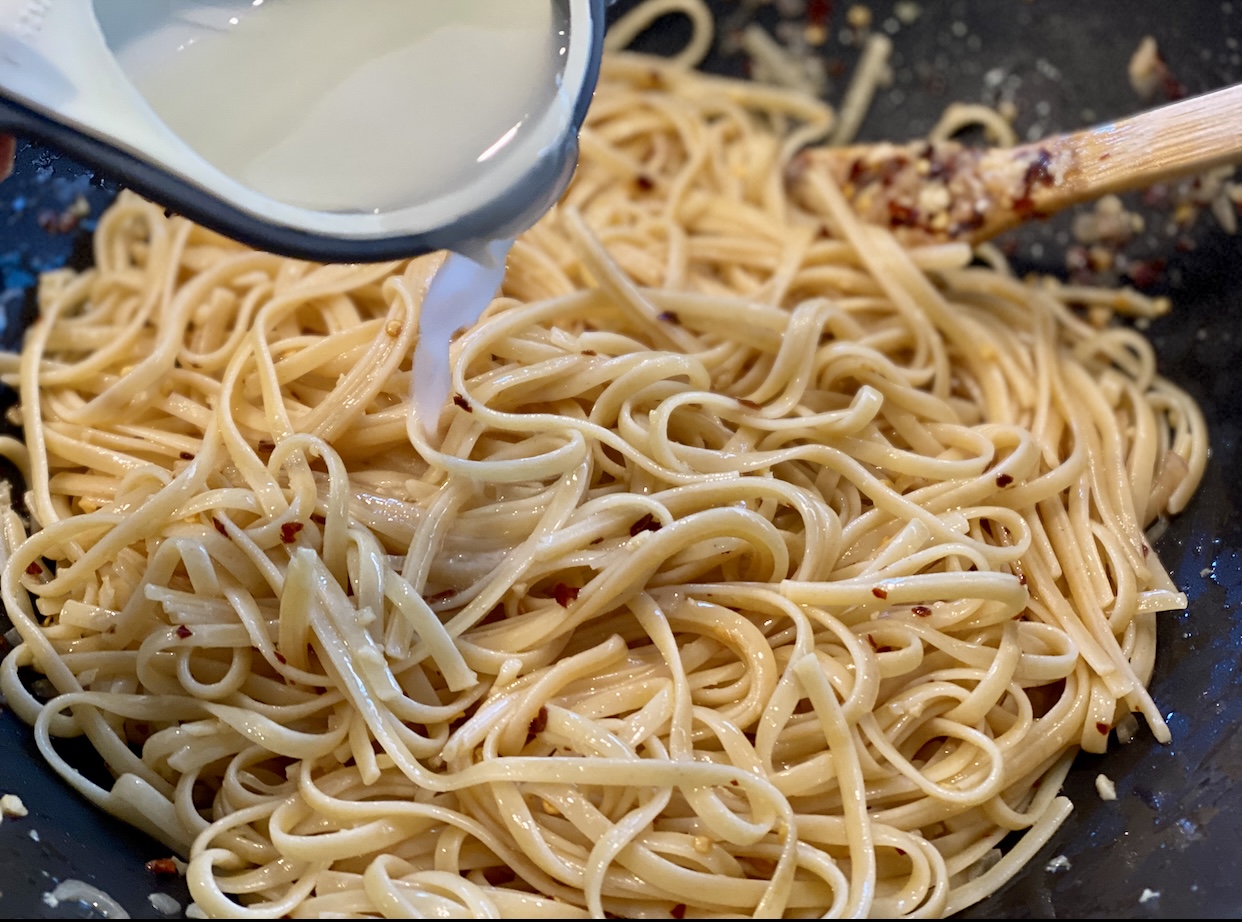
Add the pasta to the pan along with the salt. If the pasta appears dry, add a few tablespoons of the saved pasta water to loosen it, then stir through.
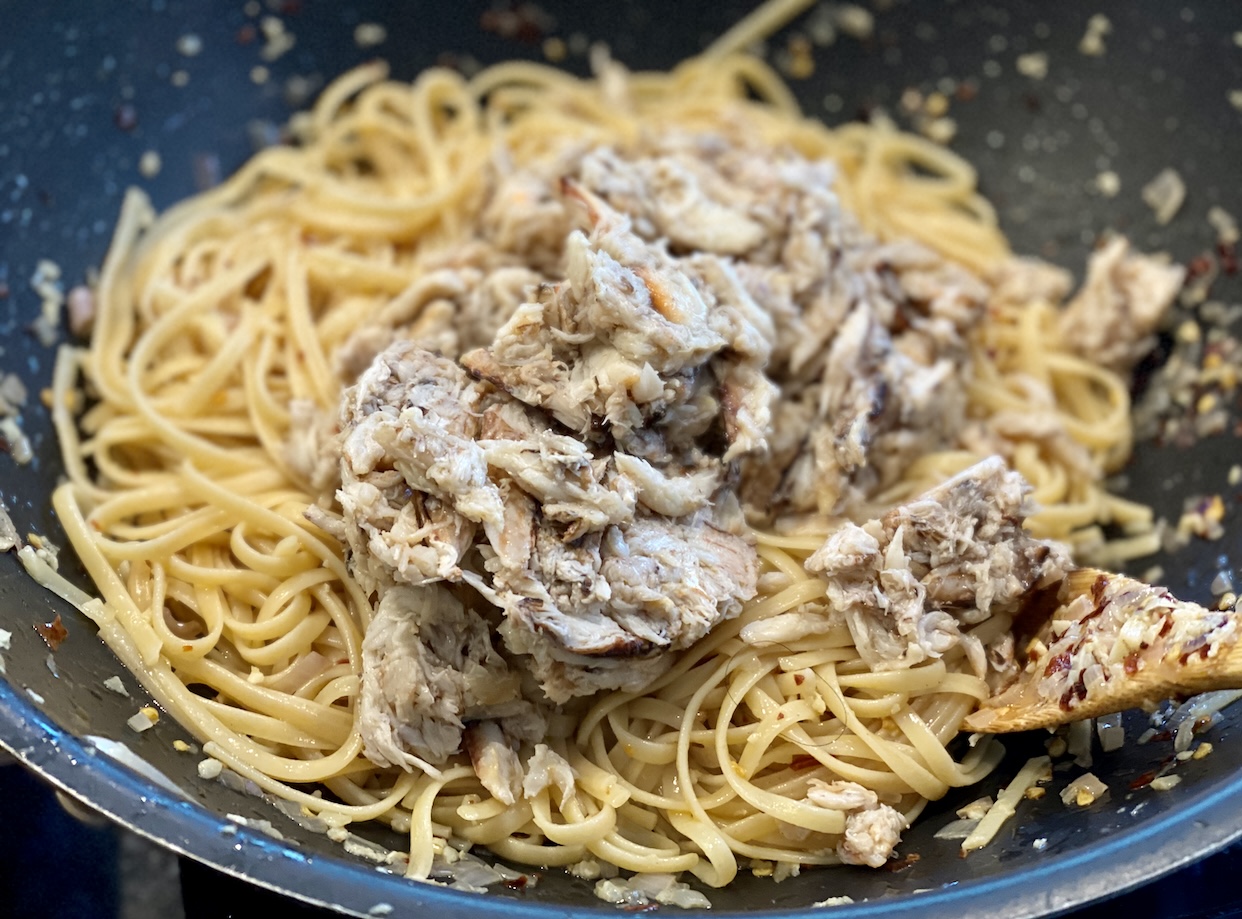
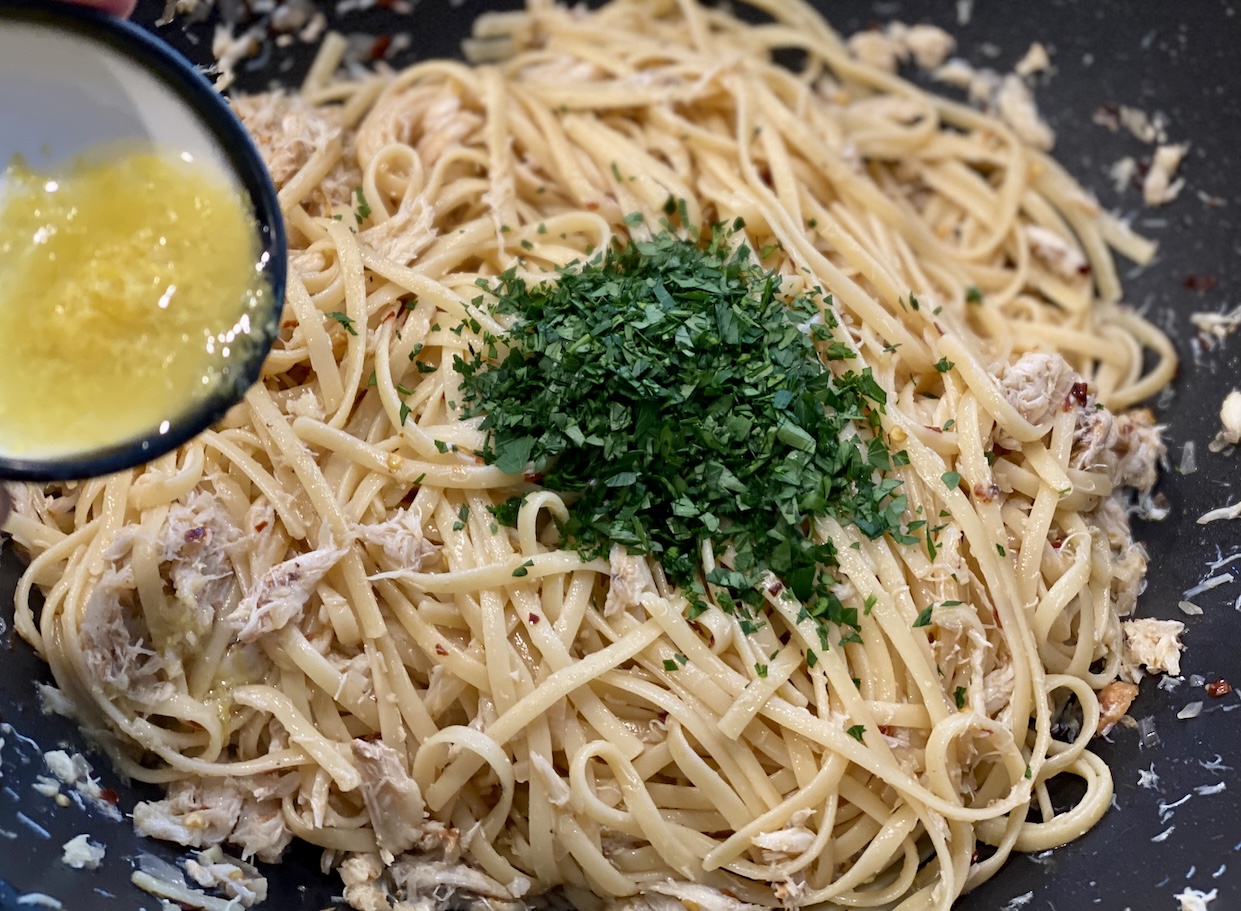

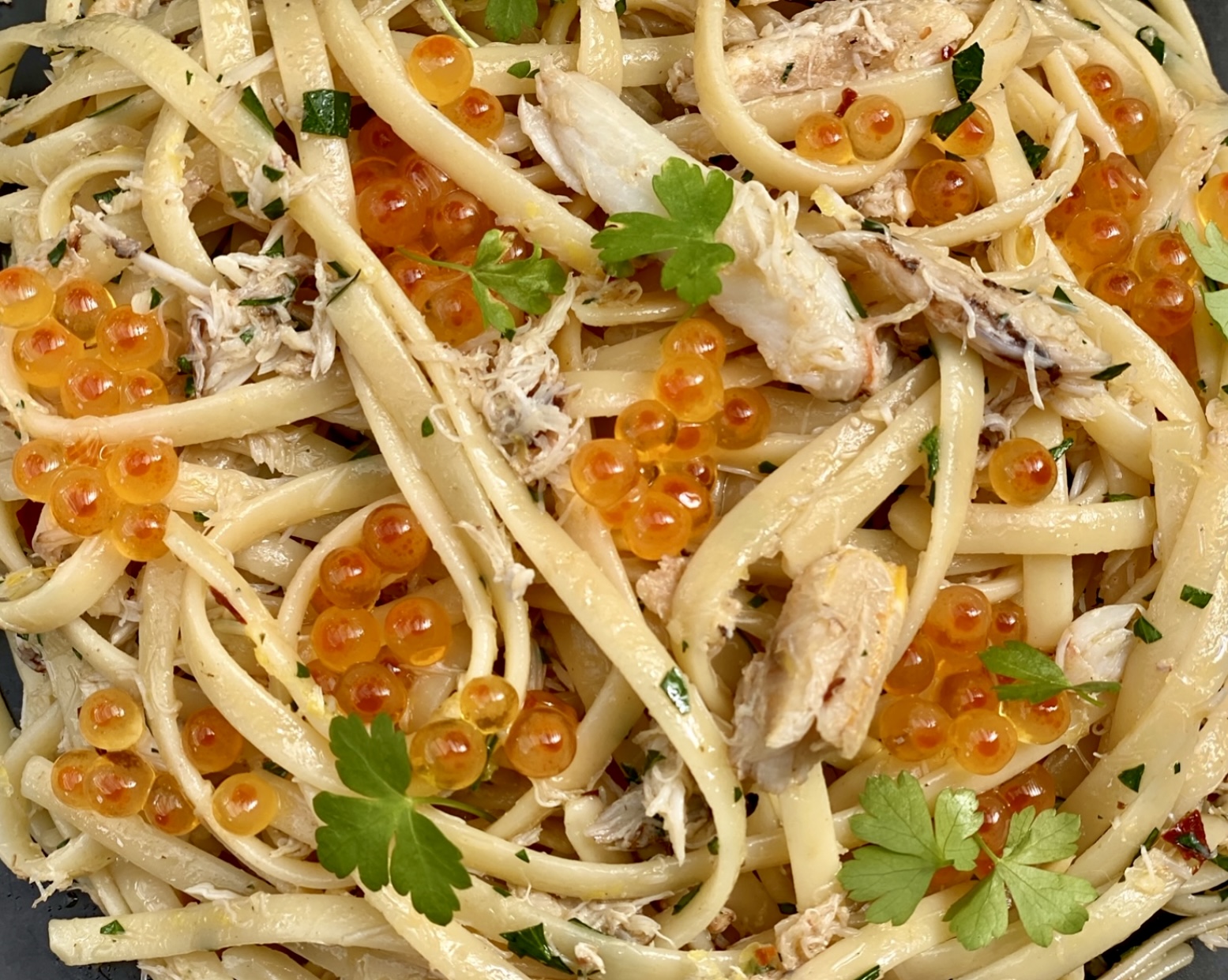
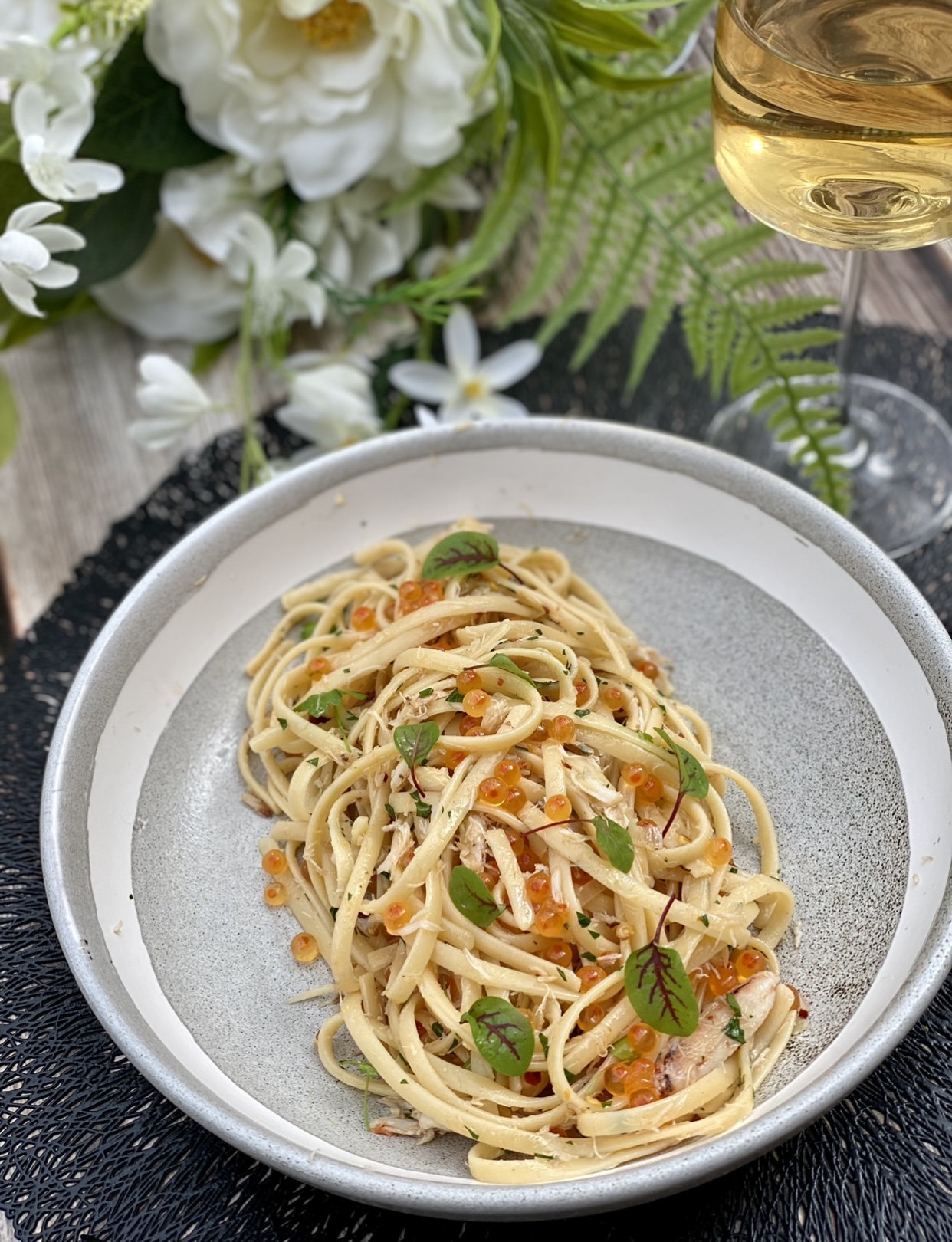
Add the crabmeat to the pasta and stir gently because you don’t want to break up the nice chunks of crab. Have a taste of the pasta and add more salt or pepper if needed. Once the pasta and crab are heated through, remove the frying pan from the heat. Then stir in the parsley, lemon rind and juice.
Place the pasta in a serving bowl or plate, spoon on some caviar and place some micro-herbs (optional). Serve with freshly grated parmesan cheese (optional).
Leftovers – Allow pasta to cool completely at room temperature, then transfer into an airtight container. Store leftovers in the fridge for up to 2 days (without the caviar on top).
I’ve used a third-party application to calculate the calories and nutritional information, so please use this as an approximate guide only.
Cooking measurements are in Australian standard spoon and cup measurements. For specific details and conversions, visit our Australian Cooking Measurements page.
I would love your feedback and support if you made this recipe. To do this, please rate this recipe and provide a comment by scrolling down this page or by clicking that green circle on the bottom left. An email address is required (for spam), but it won’t be published. I would also love to see your dish, so don’t forget to tag me on my Instagram account ‘3catsfoodie’
Cheers – Cat T
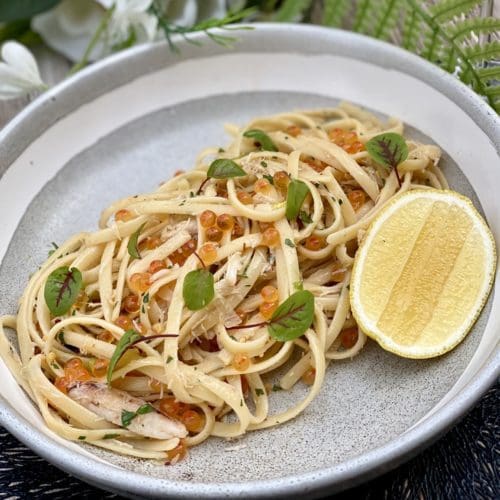
Crab Linguine
Ingredients
- 300 gm dried linguine (NOTE 1)
- ½ cup pasta water
- ¼ cup olive oil
- 30 gm unsalted butter
- 3 cloves garlic (minced)
- ⅓ cup finely chopped eschalot (NOTE 2)
- 1 tsp dried chilli flakes
- 3 tbsp dry white wine (NOTE 3)
- ½ tsp salt
- 400 gm cooked crab meat (NOTE 4)
- 2 tbsp finely chopped flat-leaf parsley
- 1½ tbsp fresh lemon juice
- 1 tsp lemon rind (finely grated)
- 3 tbsp salmon caviar (or roe) (NOTE 5)
- salt and pepper to taste
- fresh grated parmesan cheese to serve (optional)
Instructions
- Cook the pasta as per the instructions on the packet but make sure not to overcook it. The pasta should be a little firm when bitten (al dente). Scoop half a cup of pasta water and set aside, then drain the pasta using a colander. Rinse the pasta with cold water and set it aside in the colander for later.

- Heat the oil in a large and deep-frying pan over medium-high, then add the butter. Once the butter has melted, add in the garlic, eschalot, and chilli flakes. Stir quickly for 30 seconds or until aromatic, but don't let it burn. Pour in the wine and cook until the alcohol smell disappears.

- Add the pasta to the pan along with the salt. If the pasta appears dry, add a few tablespoons of the saved pasta water to loosen it, then stir through.

- Add the crabmeat to the pasta and stir gently because you don't want to break up the nice chunks of crab. Have a taste of the pasta and add more salt or pepper if needed. Once the pasta and crab are heated through, remove the frying pan from the heat. Then stir in the parsley, lemon rind and juice.

- Place the pasta in a serving bowl or plate, spoon on some caviar and place some micro-herbs (optional). Serve with freshly grated parmesan cheese (optional).


